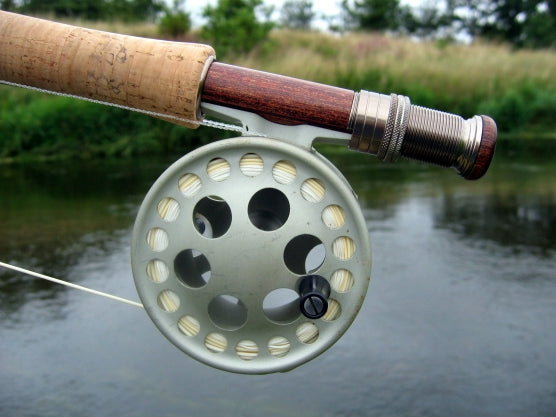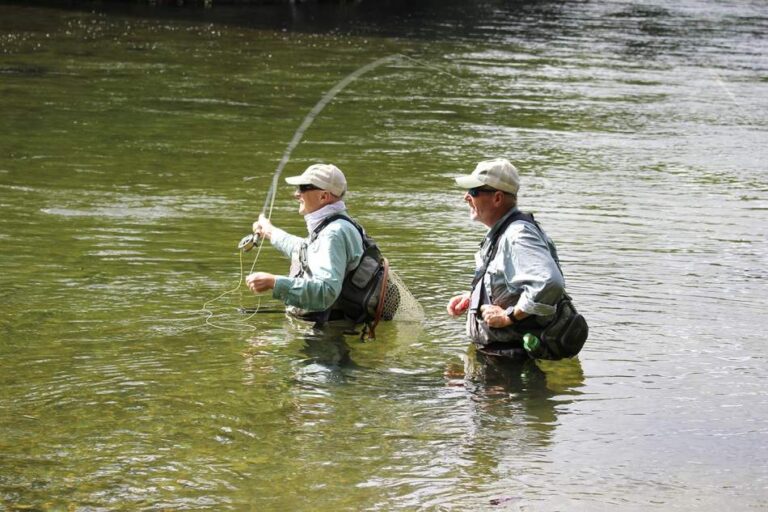Fly fishing gear is expensive due to the high-quality materials and craftsmanship required for its production.

Credit: www.outsideonline.com
The Factors Influencing The Cost Of Fly Fishing Gear
Fly fishing is a popular and rewarding hobby that attracts anglers worldwide. However, one aspect that often surprises newcomers to the sport is the cost of fly fishing gear. From the rods and reels to the flies and lines, everything seems to come with a hefty price tag.
But why is fly fishing gear so expensive? Let’s delve into the factors that influence the cost of fly fishing gear.
Raw Materials
- The raw materials used to manufacture fly fishing gear play a significant role in determining its cost.
- Fly rods are commonly made from graphite, fiberglass, or bamboo, with graphite being the most popular and expensive option due to its lightweight and durability.
- Reel frames are typically made from machined aluminum, which offers strength and corrosion resistance.
- Fly lines are composed of pvc or other synthetic materials, which are durable and provide the necessary floatation and weight for casting.
- Flies are crafted using a variety of materials such as feathers, fur, and synthetics, each with different costs and properties.
High-Quality Materials Drive Up The Cost
- The use of high-quality materials is another factor contributing to the expense of fly fishing gear.
- Premium graphite materials in rod construction provide increased sensitivity and improved casting performance, but come at a higher cost.
- Reels with precision-engineered components and high-quality drag systems are designed to withstand the rigors of battle with large fish, resulting in higher prices.
- Fly lines with advanced taper designs and specialty coatings offer superior performance and durability, but these features come at a price.
- Flies tied with the finest feathers and materials not only look more realistic but also mimic the behavior of natural food sources, making them more effective but costlier.
How Different Materials Affect Pricing
- Graphite fly rods, known for their sensitivity, strength, and lightweight nature, tend to be more expensive than fiberglass or bamboo rods.
- Machined aluminum reel frames are costlier than die-cast ones due to the precise machining process that ensures higher quality and durability.
- The type and quality of fly line coatings affect both its performance and price. Advanced coatings like slick or textured designs enhance casting distance and floatation but come at a premium.
- The materials used in tying flies vary in price. Exotic feathers or synthetics can significantly drive up the cost of flies, while simpler patterns with more readily available materials tend to be cheaper.
By considering the raw materials, high-quality craftsmanship, and the impact of different materials on performance, it becomes clear why fly fishing gear often carries a hefty price tag. Nevertheless, investing in quality gear is essential for an enjoyable and successful fly fishing experience.
So, the next time you shop for fly fishing gear, remember that while the cost may be higher, the rewards and satisfaction it brings are priceless.
The Innovation And Technology Behind Fly Fishing Gear
Fly fishing gear is often associated with high price tags, leaving many anglers wondering why this equipment comes with such a hefty cost. The truth lies in the innovation and technology behind these tools, as they are designed to optimize performance and enhance the angling experience.
Let’s dive deeper into the factors that contribute to the expensive nature of fly fishing gear.
Research And Development Costs
- Companies invest significant resources in researching and developing new fly fishing gear.
- This involves conducting extensive studies, tests, and evaluations to create products that perform exceptionally well.
- These costs are then passed on to the consumer, driving up the price of the gear.
Advancements In Design And Engineering
- Fly fishing gear has come a long way from its humble beginnings, with advancements in design and engineering playing a crucial role in its evolution.
- Cutting-edge technologies and materials are used to create lightweight, durable, and high-performing gear.
- Design improvements enhance casting accuracy, line control, and overall fishability, providing anglers with a competitive edge.
The Impact On Pricing
- With the constant progress and refinement in fly fishing gear, the price naturally increases to cover the costs associated with innovation and development.
- Higher quality components and materials translate to a higher price point, ensuring that anglers have access to superior equipment.
Cutting-Edge Manufacturing Processes
- The production of fly fishing gear often involves complex and specialized manufacturing techniques.
- These processes require the use of advanced machinery, which can be expensive to acquire and maintain.
- Handcrafted elements, such as intricately designed fly rods, also contribute to the overall price of the gear.
Costly Machinery And Equipment
- To meet the demands of producing high-quality fly fishing gear, manufacturers need to invest in state-of-the-art machinery and equipment.
- The cost of these tools is reflected in the final price of the gear.
- Precision instruments are necessary during manufacturing to ensure that every component meets strict quality standards.
Specialized Labor And Expertise
- Crafting fly fishing gear requires skilled labor and expertise.
- Highly trained professionals with years of experience are involved in the production process.
- The expertise required to create and assemble these intricate pieces further adds to the final cost of the gear.
The innovation and technology behind fly fishing gear contribute significantly to its expensive nature. From extensive research and development to advancements in design and engineering, every aspect is carefully considered to enhance the angling experience. The costs associated with cutting-edge manufacturing processes, specialized labor, and high-quality materials all contribute to the higher price tags.
Anglers can take solace in knowing that their investment goes towards equipment that is built to perform and withstand the test of time.
The Economics Of The Fly Fishing Industry
Fly fishing gear can be quite expensive, and for those who are new to the sport, it may seem like an unnecessary splurge. However, understanding the economics of the fly fishing industry can shed some light on why these products come with a higher price tag.
From the limited market size to branding strategies, several factors contribute to the cost of fly fishing gear. Let’s dive into the key elements that make fly fishing gear so expensive.
Limited Market Size
- Fly fishing is a niche hobby enjoyed by a relatively small number of enthusiasts compared to other outdoor activities such as hiking or camping.
- The limited market size means that manufacturers have fewer potential customers, resulting in higher production costs per unit.
- Unlike mass-produced equipment, fly fishing gear requires more specialized manufacturing processes and materials due to its specific design and functionality.
Demand And Supply Imbalance
- The demand for fly fishing gear exceeds the supply, leading to a demand and supply imbalance in the industry.
- This scarcity of supply gives manufacturers more freedom to increase prices without losing customers.
- Moreover, the specialized nature of fly fishing gear limits competition and reduces the downward pressure on prices.
The Effect On Pricing
- The limited market size and demand and supply imbalance directly impact pricing in the fly fishing industry.
- Manufacturers must cover their higher production costs, including research and development, machinery, labor, and materials.
- Higher manufacturing costs, combined with limited competition, create an environment where prices remain high to ensure profitability.
Branding And Marketing Strategies
- Brands play a crucial role in the pricing of fly fishing gear.
- Companies invest heavily in marketing efforts, including sponsorship of professional anglers, advertising campaigns, and trade show appearances.
- Effective branding and marketing strategies not only drive up brand value but also justify higher prices by associating the products with quality and prestige.
Premium Brands And Their Pricing Strategies
- Premium fly fishing gear brands often command higher prices due to their reputation, quality, and exclusivity.
- These brands cater to the desires of seasoned anglers who are willing to invest in top-of-the-line equipment.
- The price of premium brands reflects the craftsmanship, durability, advanced technology, and superior performance offered by their products.
Perception Of Quality And Exclusivity
- The perception of quality and exclusivity plays a significant role in the pricing of fly fishing gear.
- Many anglers believe that higher-priced gear is of superior quality, regardless of its actual performance.
- Exclusivity and limited availability further contribute to the perception that expensive gear is necessary for a true fly fishing experience.
Fly fishing gear’s high prices are rooted in the economics of the industry. The limited market size, demand and supply imbalance, branding and marketing strategies, premium brands, and the perception of quality and exclusivity all contribute to the higher cost of these products.
Understanding these factors can help anglers appreciate the value associated with their fly fishing gear and the investment they make in their chosen hobby.
The Additional Costs Associated With Fly Fishing Gear
Fly fishing gear often comes with a hefty price tag, leaving many anglers wondering why it’s so expensive. While there are various factors that contribute to the high cost, one significant aspect is the additional expenses associated with fly fishing gear.
In this section, we’ll delve into these costs and shed light on why fly fishing gear can be quite pricey.
Packaging And Presentation
- Fly fishing gear often comes in well-designed and aesthetically pleasing packaging, which adds to its appeal and marketability.
- Packaging is carefully crafted to protect the gear during transportation and storage, ensuring it reaches the customer in perfect condition.
- The cost of creating and designing high-quality packaging is factored into the overall price of the gear.
Impact On Overall Cost
- The additional costs associated with fly fishing gear, such as packaging, presentation, and marketing, significantly impact the overall cost.
- Manufacturers have to recover these expenses by increasing the price of the gear to maintain profitability.
- This is why fly fishing gear appears more expensive compared to other types of fishing equipment.
Distribution And Retail Markup
- Fly fishing gear goes through a distribution network before reaching the retail stores.
- Each entity involved in the distribution chain – from manufacturers to wholesalers and retailers – adds a markup to the original cost of the gear.
- The cumulative effect of these markups increases the price significantly.
Expenses Passed On To Consumers
- Manufacturers incur various costs during the production process, including research and development, raw materials, labor, and overhead expenses.
- To cover these costs, manufacturers pass them on to consumers in the form of higher prices.
- The unique nature of fly fishing gear, which requires specialized materials and construction techniques, further contributes to the expense.
Warranty And Customer Support
- Quality fly fishing gear often comes with warranties and exceptional customer support services.
- Manufacturers invest in offering extensive warranties to assure customers of the gear’s durability and reliability.
- The cost of providing these warranties and customer support are reflected in the price of the gear.
Added Value And Cost Considerations
- Fly fishing gear often incorporates advanced technology and innovative features, adding value to the product.
- Research and development of new technologies and materials drive up production costs, which are passed on to the consumers.
- The cost of producing reliable and high-performance gear also includes rigorous quality control and testing processes.
The additional costs associated with fly fishing gear contribute significantly to why it is expensive. From packaging and presentation to distribution markups and warranty expenses, every aspect adds to the overall cost. Nonetheless, the quality, craftsmanship, and added value provided with fly fishing gear make it a worthwhile investment for avid anglers.
Conclusion
Fly fishing gear can be expensive, but there are valid reasons behind these high costs. The durability and quality of materials used, coupled with the precision engineering involved in producing high-performance gear, contribute to the price tag. Craftsmanship and innovation are evident in each component, ensuring that anglers have efficient and effective tools at their disposal.
While cost may initially seem prohibitive, investing in top-tier gear pays off in the long run, as it will last longer, perform better, and enhance the overall fishing experience. Additionally, the fly fishing industry supports local businesses, artisans, and conservation efforts, making the price worth paying.
So, while it may seem daunting to shell out for fly fishing gear, understanding the value and benefits associated with it can make the investment an easier pill to swallow. After all, the joy and satisfaction of an optimal fishing experience is priceless.






